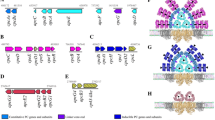Abstract
The separation of light-harvesting peptides by RP-HPLC is notoriously difficult due to the typically strong interaction of peptides with the column matrix, their relatively low solubility in the mobile phase and the tendency for non-specific aggregation during sample preparation. This paper illustrates a reproducible method for investigating the composition of four spectrally different forms of LH2 isolated from Rps. palustris. The method contrasts with previous attempts to isolate peptides from these multi-LH2 complexes and uses the well characterised B800–850 complex from Rps. acidophila as a test of reliability. Three pairs of LH2 peptides, αβa, αβb and αβd, were identified from Rps. palustris grown under high- (7000 lux) or intermediate- (1000 lux) light conditions. At lower light (300 and 90 lux), αβb was absent, and the level of αβa was significantly reduced. Results show that αβa and αβb peptides form the high light B800-850 complex, whereas the low light LH2 complex is only composed of αβd peptides and resembles the B800–820 complex from Rps. acidophila by sequence homology. The absorption spectrum of this complex has a single peak centred on 800 nm and appears to be a novel LH2 complex. At low light growth conditions, this B800 species is the predominant LH2 complex in Rps. palustris and indicates that peptide expression is a crucial factor in adapting to different light intensities.
Similar content being viewed by others
References
Altschul SF, Gish W, Miller W, Myers EW and Lipman DJ (1990) Basic local alignment search tool. J Mol Biol 215: 403–410.
Bollhagen R, Schmiedberger M and Grell E (1995) High performance liquid chromatographic purification of extremely hydrophobic peptides: Transmembrane segments. J Chromatogr A, 711: 181–186
Drews G (1991) Regulated development of the photosynthetic apparatus in anoxygenic bacteria. In: Bogorad I and Vasil IK (eds) The Photosynthetic Apparatus, pp 113–148. Academic Press, San Diego, CA
Evans MB, Hawthornthwaite AM and Cogdell RJ (1990) Isolation and characterisation of the different B800–850 lightharvesting complexes from low-and high-light grown cells of Rhodopseudomonas palustris, strain 2.1.6. BBA 1016: 71–76
Fowler GJS and Hunter CN (1996) The synthesis and assembly of functional high and low light LH2 antenna complexes from Rhodopseudomonas palustris in Rhodobacter sphaeroides. J Biol Chem 271: 13356–13361
Germeroth L, Lottspeich F, Robert B and Michel H (1993) Unexpected similarities of the B800–850 light-harvesting complex from Rhodospirillum molischianum to the B870 light-harvesting complexes from other purple photosynthetic bacteria. Biochemistry 32: 5615–5621
Kerfeld CA, Yeates TO and Thornber JP (1994) Purification and characterisation of the peripheral antenna of the purple-sulphur bacterium Chromatium purpuratum: Evidence of an unusual pigment-protein composition. Biochemistry 33: 2178–2184
Kramer H, Deinum G, Gardiner AT, Cogdell RJ, Francke C, Aartsma TJ and Amesz J (1995) Energy transfer in the photosynthetic antenna system of thepurple non-sulphur bacterium Rhodopseudomonas cryptolactis. BBA 1231: 33–40
Laemmli UK (1970) Cleavage of structural proteins during the assembly of the head of bacteriophage T4. Nature 227: 680–685
Lee R, Doughty SW, Ashman K and Walker J (1996) Purification of hydrophobic integral membrane proteins from Mycoplasma hyopneumoniae by reversed-phase high performance liquid chromatography. J Chromatogr A 737: 273–279
McDermott G, Prince SM, Freer AA, Hawthornthwaite-Lawless AM, Papiz MZ, Cogdell RJ and Isaacs NW(1995) Crystal structure of an integral membrane light-harvesting complex from photosynthetic bacteria. Nature 374: 517–521
Parkes-Loach PS, Sprinkle JR and Loach P (1988) Reconstitution of the B873 light-harvesting complex of Rhodospirillum rubrum from the separately isolated α-and β-polypeptides and bacteriochlorophyll a. Biochemistry 27: 2718–2727
Prince SM, Papiz MZ, Freer AA, McDermott G, Hawthornthwaite-Lawless AM, Cogdell RJ and Isaacs NW Apoprotein structure in the LH2 complex from Rhodopseudomonas acidophila strain 10050: Modular assembly and protein pigment interactions. J Mol Biol 268: 412–423
Tadros MH, Katsiou E, Hoon MA, Yurkova N and Ramji DP (1993) Cloning of a new antenna gene cluster and expression analysis of the antenna gene family of Rhodopseudomonas palustris. Eur J Biochem 217: 867–875
Tadros MH and Waterkamp K (1989) Multiple copies of the coding regions for the light-harvesting B800–850 α-and β-polypeptides are present in the Rhodopseudomonas palustris genome. EMBO J 8: 1303–1308
Zuber H and Brunisholz R (1991) Structure and function of antenna polypeptides and chlorophyll–protein complexes: Principles and variabilty. In: Scheer H (ed) The Chlorophylls, pp 627–703. CRC Press, Boca Raton, FL
Author information
Authors and Affiliations
Rights and permissions
About this article
Cite this article
Tharia, H.A., Nightingale, T.D., Papiz, M.Z. et al. Characterisation of hydrophobic peptides by RP-HPLC from different spectral forms of LH2 isolated from Rps. palustris. Photosynthesis Research 61, 157–167 (1999). https://doi.org/10.1023/A:1006281532327
Issue Date:
DOI: https://doi.org/10.1023/A:1006281532327




